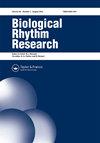在一天中的不同时间,雌性和雄性之间,蒙氏两代Cambarellus的假定起搏器中的组胺样免疫反应性
IF 0.9
4区 生物学
Q3 BIOLOGY
引用次数: 0
摘要
本文章由计算机程序翻译,如有差异,请以英文原文为准。
Histamine-like immunoreactivity in the putative pacemaker of two Cambarellus montezumae generations at different times of day, between females and males
ABSTRACT In different organisms, histamine (HA) is related to biological rhythms, moderating the circadian rhythm of the neuroendocrine system. Nevertheless, no work has been done on the putative pacemaker of the endemic crayfish, Cambarellus montezumae, wich threatened by anthropocentric modifications of its habitat. The aims of the present work were to evaluate the daily presence and localization of HA in two structures proposed as putative pacemakers of the crayfish, the eyestalk and the brain in females and males. We also evaluated whether there are changes in the F0 generation with respect to the F1 generation. Adult crayfish were used, euthanized at different times of day, to excise the eyestalk and brain and process them through immunohistochemical techniques. The results obtained showed that the immunopositivity to HA in the eyestalk and brain of the crayfish undergoes daily variations in both females and males, as well as between the F0 and F1 generations.
求助全文
通过发布文献求助,成功后即可免费获取论文全文。
去求助
来源期刊

Biological Rhythm Research
生物-生理学
CiteScore
3.00
自引率
9.10%
发文量
34
审稿时长
6-12 weeks
期刊介绍:
The principal aim of Biological Rhythm Research is to cover any aspect of research into the broad topic of biological rhythms. The area covered can range from studies at the genetic or molecular level to those of behavioural or clinical topics. It can also include ultradian, circadian, infradian or annual rhythms. In this way, the Editorial Board tries to stimulate interdisciplinary rhythm research. Such an aim reflects not only the similarity of the methods used in different fields of chronobiology, but also the fact that many influences that exert controlling or masking effects are common. Amongst the controlling factors, attention is paid to the effects of climate change on living organisms. So, papers dealing with biometeorological aspects can also be submitted.
The Journal publishes original scientific research papers, review papers, short notes on research in progress, book reviews and summaries of activities, symposia and congresses of national and international organizations dealing with rhythmic phenomena.
 求助内容:
求助内容: 应助结果提醒方式:
应助结果提醒方式:


